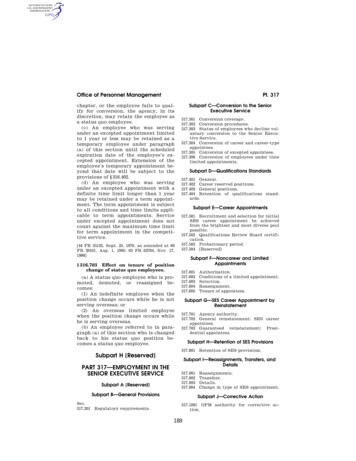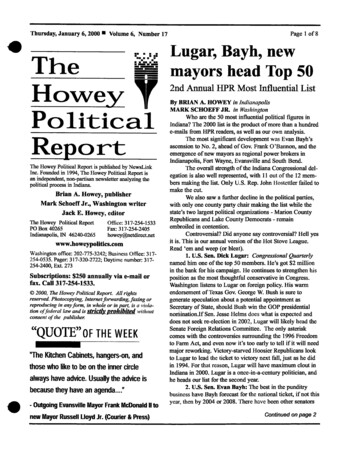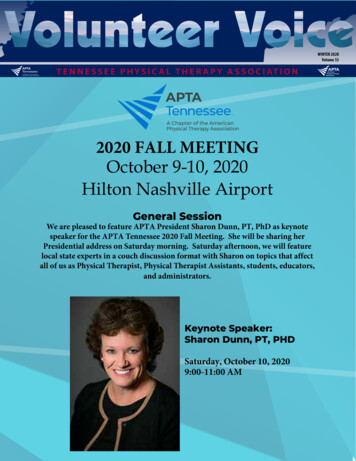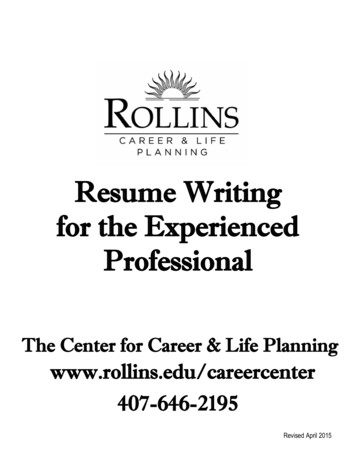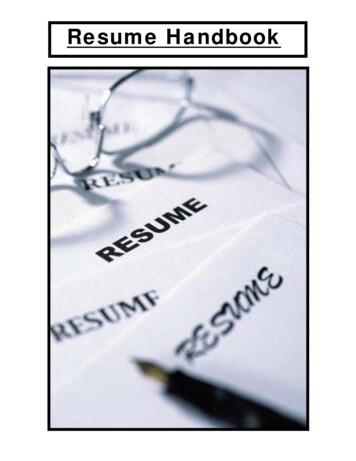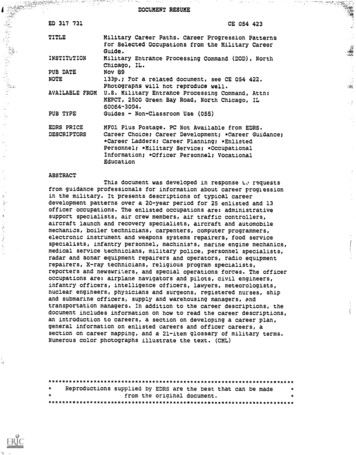
Transcription
DOCUMENT RESUMEED 317 731TITLEINSTITUTIONPUB DATENOTEAVAILABLE FROMPUB TYPEEDRS PRICEDESCRIPTORSCE 054 423Military Career Paths. Career Progression Patternsfor Selected Occupations from the Military CareerGuide.Military Entrance Processing Command (DOD), NorthChicago, IL.Nov 89133p.; For a related document, see CE 054 422.Photographs will not reproduce well.U.S. Military Entrance Processing Command, Attn:MEPCT, 2500 Green Bay Road, North Chicago, IL60064-3004.Guides - Non-Classroom Use (055)MF01 Plus Postage. PC Not Available from EDRS.Career Choice; Career Development; *Career Guidance;*Career Ladders; Career Planning; *EnlistedPersonnel; *Military Service; *OccupationalInformation; *Officer Personnel; VocationalEducationABSTRACTThis document was developed in response t.,.% requestsfrom guidance professionals for information about career progressionin the military. It presents descriptions of typical careerdevelopment patterns over a 20-year period for 25 enlisted and 13officer occupations. The enlisted occupations are: administrativesupport specialists, air crew members, air traffic controllers,aircraft launch and recovery specialists, aircraft and automobilemechanics, boiler technicians, carpenters, computer programmers,electronic instrument and weapons systems repairers, food servicespecialists, infantry personnel, machinists, marine engine mechanics,medical service technicians, military police, personnel specialists,radar and sonar equipment repairers and operators, radio equipmentrepairers, X-ray technicians, religious program specialists,reporters and newswriLers, and special operations forces. The officeroccupations are: airplane navigators and pilots, civil engineers,infantry officers, intelligence officers, lawyers, meteorologists,nuclear engineers, physicians and surgeons, registered nurses, shipand submarine officers, supply and warehousing managers, andtransportation managers. In addition to the career descriptions, thedocument includes information on how to read the career descriptions,an introduction to careers, a section on developing a career plan,general information on enlisted careers and officer careers, asection on career mapping, and a 21-item glossary of military terms.Numerous color photographs illustrate the text. **************************Reproductions supplied by EDRS are the best that can be madefrom the original ******************************
er11114. 0IIA."PERMISSION TO REPRODUCE THISDEPARTMENT OF EDUCATIONEducational Research and ImprovementOfficeRESOURCES INFORMATIONEDU ATIONALCENTER (ERIC)MATERIAL IN MICROFICHE ONLYUHreproduced astis document has beenorganilalionleCO,ved from the person orer,gmetingto improveP Minor i hanges have Jeer, madereproduction Qualifyslated in this decuPoints or view or opinionsofficialment do not necessarily representpolicyOE RI position orBEEN GRANTED BY.THE FELeV.I'bNAL RESOURCES.INFORMATION CENTER (ERIC)2BEST COPY AiiiiiLABLEDoti
U.S. MILITARY ENTRANCE PROCESSING COMMAND2500 GREEN BAY ROADNORTH CHICAGO, ILLINOIS 60064-3094HOTLINE: 1-800-323-0513(WITHIN ILLINOIS, CALL COLLECT: 708-688-4922)3
Military Career PathsCareer Progression Patterns for SelectedOccupations from the Military Career GuideA companion document. Military Career Guide,is available for a description of the full range ofoccupations available in the military.
Library of Congress Catalog Card Number A8-600534Published by the U.S. Department ofDefense, Washington, D.C.Material in this publication is in the public domain and may. withappropriate credit, be reproduced without permission.
AcknowledgmentsMilitary Career Paths was developed in response to requests from guidance professionalsnationwide for information about career progression in the military. It presents descriptionsof typical career development patterns over a 20-year period for a sample of enlisted andofficer occupations. Military Career Paths was designed to complement the Military CareerGuide, a publication that describes the full range of occupations in the U.S. Armed Servicesat the journeyworker level. Military Career Paths is intended to provide a general descriptionof the military's career development process. While designed for use as a separate resource,Military Career Paths also can be used in conjunction with the Military Career Guide.Policy oversight for the development of Military Career Paths was provided by a steeringcommittee. Members of the group included Dr. W. S. Sellman and Dr. Anita Lancaster, Officeof the Assistant Secretary of Defense (Force Management & Personnel); Colonel JamesJewel, Headquarters, Department of the Army; Dr. Daniel Stabile, Naval Military PersonnelCommand; Lieutenant Colonel Thomas Copeland, Headquarters, U.S. Air Force; Dr. DouglasDavis, Headquarters, U.S. Marine Corps; Mr. Kenneth Scheflen, Defense Manpower DataCenter; and Mrs. Juliette Lester, National Occupational Information Coordinating Committee.Their efforts on behalf of this project are appreciated.Military Career Pathswas developed under the technical supervision of a working group thatincluded Mr, John Richards and Dr. Jerome Lehnus, Defense Manpower Data Center;/1. Janet Treichel and Major Jan Eakle, Office of the Assistant Secretary of Defense (ForceManagement & Personnel); Sergeant Major Sharon Weikel, Lieutenant Colonel UlrichNienhagen, and Mr. Ronald Patsy, Department of the Army; Mr. Dolt Shotts, Naval MilitaryPersonnel Command; Mr. Lawrence Burns and Mr. Steven Muir, Navy Recruiting Command;Ms. Ruth Berry, Ms. Phyllis Lobdell, and Captain Michael Begley, Air Force Military PersonnelCenter; Dr. Mbttha Brownlee, Ms. Nelvin Thibodeaux, and Lieutenant Colonel Walter Jones,Headquarters, U.S. Marine Corps; Mr. Dennis Gaynor, Military Entrance Processing Command; Mr. Richard Lanterman, Lieutenant Commander Kay Hartzell, and Dr. Robert Frey,Headquarters, U.S. Coast Guard; and Dr. Harvey 011is, National Occupational InformationCoordinating Committee. We are grateful for their careful scrutiny of the technical underpinnings of this book, as well as their tireless review of the narrative. We also appreciate theguidance provided by Ms. Beth Simon, Military Entrance Processing Command; Mr. MasonCarl, Office of the Secretery of Defense Graphics Department; and Ms. Kathryn Mitchell ofMitchell & Mitchell Inc., for the design of Military Career Paths. Mr. Jack Arthur, CreativePresentation Inc., was the cover artist.Under contract to the Department of Defense for this effort were occupational informationdevelopment experts from the Texas State Occupational Information Coordinating Committee (TSOICC) and its subcontractors, Booz, Allen & Hamilton Inc. and the Texas EmploymentCommission, Mr, Michael Fernandez, TSOICC Executive Director, provided oversight for theproject. Mr. Paul Myers of Booz, Allen & Hamilton Inc. was project manager. The contributionsof Booz, Allen analysts Mr. Gregg Wright, Mr. Jeffrey Worst, Ms. Anne Kamstra, and Mr. ClydeLutter are gratefully acknowledged. Ms. Linda Pfister developed the exercises. Ms. SharonSeminerio provided computer graphics, and typesetting support. The Texas EmploymentCommission analysts included Mr. Larry Hunt, Mr. Don Hill, Mr. Kenneth Keil, and Mr, JohnOlrech III, Their efforts are appreciated.6
ContentsHow to Read the Career DescriptionsivGeneral Information on Officer Careers76Introduction to Careers2Examining Officer Career Descriptions87Developing Your Own Career Plan7Sample of Military Officer Career DescriptionsGeneral Information on Enlisted Careers10Examining Enlisted Career Descriptions21Sample of Military Enlisted Career DescriptionsAdministrative Support SpecialistsAir Crew MembersAir Traffic ControllersAircraft Launch and Recovery SpecialistsAircraft MechanicsAutomobile MechanicsBoiler TechniciansCarpentersComputer ProgrammersElectronic Instrument RepairersElectronic Weapons Systems RepairersFood Service SpecialistsInfantrymenMachinistsMarine Engine MechanicsMedical Service TechniciansMilitary PolicePersonnel Specia:i:;!sRadar and Sonar Et. iiipment RepairersRadar and Sonar Op:,er-itorsRadio Equipment RepairersRadiologic (X-Ray) TechniciansReligious Program SpecialistsReporters and NewswritersSpecial Operations ForcesMilitary Career 870Airplane NavigatorsAirplane PilotsCivil EngineersInfantry OfficersIntelligence OfficersLawyersMeteorologistsNuclear EngineersPhysicians and SurgeonsRegistered NursesShip and Submarine OfficersSupply and Warehousing ManagersTransportation Managers102104106108110112114Career Mapping117Glossary of Military Terms122909294969810072iii
How to Read the CareerDescriptionsThe purpose of Military Career Paths isto explain military career opportunities tostudents, counselors, and parents. It canbe used to explore enlisted and officercareers in the Army, Navy, Air Force, Marine Corps, and Coast Guard. MilitaryCareer Paths describes the typical dutiesand assignments for a person advancingalong the path of a military career. In total,25 enlisted and 13 officer occupations aredescribed in Military Career Paths. Eachcareer description has standard sectionsas shown in the example below.IntroductionMilitary Service RepresentationThe "Introduction" summarizes the jobduties and the caree. path for the militaryoccupation.The military services. listed next to thetitle. offer employment and training oppor-tunities in the occupation. Exceptions tothe "Typical Career Path" are explained atthe end of the "Duty Assignment" section.When reading any one of the 33 careerdescriptions, remember that it is a sum-ARMYNAVYAIR FORCEMARINE CORPSAIR TRAFFIC CONTROLLERSmary of career paths in similar job specialties across two or more military services.Individual career paths may differ somewhat from the general descriptions in thistratsc controaers work In The nervecenter of a mIttary ai0 As an a,Pathc controller you dreCt ant att nto outof and around aelOS o' d 'Crab Carnerf,-.1111/11. -book. If you are interested in learning moreYou begin your Career uncle' Coat, Supervision tearnmg to Ore( lakeottc tartdngsand runway tratl.c frOnt a control tower oabout a particular service or occupationyou should contact a recruiter for details.radar centerSkillAs yOu ga n evper-ecce andyou work more depenclently andqke on more daficull tasks There are opoutunitios for advancement to Supev So,Career Titleof a control tower or radar center andpeas to faCtbly sun enPsor m charge 0'vat tral cOntro' for an enure a1,00The career title names the military occupation,DUTY ASSIGNMENTArt tra11.0 C0o1rOl'e'S uSuy work in InfoContrOt lower or radar center 01 3 maaryalie!Cl Some controiters work aboardaircraft LarberS or at ternooral, '3,(1111Strips near combat /Ont.!, The cerviceshave aahetcIS 311 Over the Untied StatesThere alr.0 good oppOrtunity tor assgnPhotographOne or more photographs illustrate theoccupational duties performed.men ,31 one of the many OverStraS 11,.4,0Stales sauce aatelds or at an atela runProfile: David MartinezProfileSOCas.naby alnecl Forces whereCOntrollerS are sOrnt!VIeS neededDa. a r.tartnez dad not see any fuld,lbe hometown paper ma,'''s ,Obneeded some educaan a'dThe "Profile" describes the actual duties,r11 was marred and na0 chawenMaarefobheex0,aa'S So Dawn enlisted m the Mannyand assignments of a military enlistedCorps wart a guarantee to work .n avaatmember or officer during his or her career.basrc emn "g David went to schoolBecause each individual career path isunique and spans many years, some as-eertded 'or 11s type CI WWk he am He was se ecle0 tor ae pada: coetrol AtterGm"( Oe GA to ream !Owe, and radar atratt: control Saute federal 1ni ensek are,arn,.(11,5,1-nfioral Av.,1100 kinnar.S1'.11.01'of AA, opnalOr S ra,1.1.r ate The: .tr-terlsignments will not be typical or representa-0 t1. 'oat toward becoma,0 F AAtbbted Icr work a., tradrc C'I'tive of current policy. However, the flavorThe Ivey! 8 yells went last flavalaccorenehts wr,e 9314 between JaimeOnry bonland New II,vr SOrnntmrSAI h., sea .lsvetthmeet re New Fin.NCDvd was .1 iOvver air 1/.111K COn1r0::,/}I d,11100 n grOond iOntr01 butillustrated in the "Profile." The names in:,.1.rthe profiles have been changed for privacypurposes.0!red .(peer.ann ''.r ratindrCI 10 rrCtrOr.:ha. a 1,01 114 ar1,,c11t),in( ane watta,I)P.VsOt11,1.4vt.1. al New IIver he arb. at erabon! pbv,vie 1- .I , %ea,'!01.,a.1.,ee,1 (bayn1-awa,-"CIl You are interested u, r paha- C 0.11'01you ;nay .use Want 10 COnsOnr .1 C.Venr as,1.ySlemS Sbor ral.st 11Th( OD ",lbons %perst radar I'd SOda' OPerateryt.,11," Ont, 131,1Cr. '1'.0 ii na0 10 4pUtr.1,11,ot ad, rall OunCh and rvv overt, ,IN'C',11.c!Sr the 1afol,i1, arer', (1,,th- lor avma,r)!ocP P11' h'cP0hstlaY hem radar v antrul.e0',,10IrsCr 'o sensor r',.r .'rd.h ' IY Wqta1-1 .0 Vay-onrl 10 a 1 y.if !0.0 Isar,i.a.- I itrO.,',Or1 w 1 as thew 0,1 and radar lerom h(ee(1.11.1Now.s.srrr AA Qua aedn !Ow,: , 0,-1,01 .Ind for 114 Nr.v. 11.yrr . vin.RELATED MILITARYOCCUPATIONS10 wOn, a! Oat, nr.W 1,11asty but O., , ar,oh"' ',11"110 0" Ho was tromoted 10 aun01nrry nergt,arrr nC1 moved mln poc t'at nlyand activities of a full career are accurately11/hty rate(' Na.C11 warn' that ht co,:awcek any air Pattc central omal,ort al the,11X) sow,' l sbOrt {ran' YumaAZ as a C.ontroer and was DrOn01141 10SrOV,InttacaoWA,yh. 'fCSi tql.1111POrt Ntu.ila,e(1," Inn radar aa 'r.111:t11, ,.1,un'an. lase'v and : wveked :o orhe.'y a,,v1.VPIP0a n i Orman,. as web flavat wa',loam soon but be hs., he has darn.we. n hornet,the av , era, 1 "art,01,ronnth.,.co piny rseI1,0!11.Military Career Paths
Duty AssignmentRelated Military OccupationsThroughout their careers, military personnel are assigned to new duties andlocations. This section describes the typeof military organizations and installationswhere people in this career may be assigned. It also discusses opportunities foroversell aisiynntents. Any 111810f excep-This section identifies other occupationsin the military services with similar workand career paths. Descriptions of the related occupations are in the Military CareerGuide.tions to the typical career path are noted atthe end of this section.AdvancementMilitary careers typically advancethrough three to five career levels. Promo-tion to each level requires improving jobskills and accepting more responsibility.This section describes the skills. qualities,and abilities needed to advance throughthe career levels.SpecializationThis section describes the types of jobc.,!,.11 sw.V. 0",ADVANCEMENT;;),:,0142.,a, aT,.e calt.11,.1"1.1"1 :' O"Ot.,10., on the abJ' the.0 "1,11.0 (1.,:kce,f0.1aoe,Wes:,A r 1,1".tC Ontr0,1,'STimoline(ca"a114 plot, w"0 !iy,a.Call t -tsy .nus: a,50 be ib.0"e"! e't the mo.t.ri110 dI"., arnr, 1,me,At each wrhild :''Pvass,ore to eol,olle,s0c.,lovie,s anti Oltt Pband pre,a.igio Avatt't.t. SO", "151.1 a L0 Irent.5. Ad,'' "sbav c and4 to1a "I;0,act.ce us.noc"."1:.tt", th dl S.,',uta!P.aatt,c co.,,o) ont.,al.ons1,11.0rule,) .11(1:01,01,.r0,C,11.01)1" IdO 1.00 11.1.1111PS reCe".0a,,d %lea, 0001,11.0,1CS110C1 001119,1 01,11 Ct.5 101 adysIncen,ulgou,e cent,e'Ied n00,0,10'0'0An Iran c ant:ottersPatf.c conlroqer,by the FiKit,.1'mdln1,r1115alrors and'aCla,take advanceo .aammg 0.1!req. ,1110C11t .',11.rr11ct.r1.1.( r11-00Carper Prphrm"dry ce1.1.Call0"."10,11dtql!her. omplellorl 01 1114,1, ,01' 1r,pri111.0u(1110LI!T'10Se 0,e1/11 ,1g 'OrS0.Cr.11,Ze'd WOrk .1, C0,14/11 0' Or'.rC ra11 Carr t11S must lake lunherA.I t,,if!.«/11,,y.0(.,fie.ced cont,o,les, At anleve,s 0, this csveelPan,cont'oIlt.rs must mata.the opplabOn; JI an a Wino:cG,1,0,,ento, 0' tows" Tram.ng101) c ,,c1u00 wanagopowsoophys,cal cond.1,on to O ,,,,5.1hogeht OnyS,Cd Chain; Al1untanno lq1C1 m MJ'aqa.0 (.,tab.c11.10 ,,,,ds1vOck 1110Cts(11.0t.SwahogrIt's5 10 a Surlse 'P.1051O 1.p r ore:, helps .1.1traffq't0.1t,01t.s. advan1 fluOugh the Supt.,,5,01,, level, 01 111e, Careerthe. (wet.r a, trall.ccotItolleMTPtIrn.vaowch.p pa.n.noVa. and lob eoehence-(1 ibw,ucs !f000tSPECIALIZATIONA.' :,atI,c cmay so('0, aiclar 00.,aalhouoh thvy011,151 oilL00110"0". doer I1;011:OLOCIt'S,lindal111,ni{), Tyl) :a,adrn.n.WeifroTOM 'a,:ci1,1C ,.lySu0t.,%,0' 'eve!TrainingHighly (mulled air traffic controllers may becomeThis section summarizes the militarysupervisor of a tower or radar center. Air traffic supervisorstraining provided to personnel at all careerlevels. It describes initial job training, advanced skill training, training for job specialties, and leadership training.Supervise a shift in a control tower or radar centerBrief staff on weather, local field Conditions, run-ways to be used. and other situations affectingaircraftCoordinate air traffic control with other airfieldsInspect runways and airfield facilitiesTypical Career PathCONTROLLERAs their skiffs increase. air traffic controiters take onmore difficult tasks. Typically, controllers:weatherConduct radar control of aircraft during ground orin-eight emergenciesCoordinate search and rescue missions with aircrewsGive onthelob training and technical help to newair traffic controllersAPPRENTICE CONTROLLERAfter initial lob training, apprentice controllers workunder the direct supervision of an experienced controller TheyTrack air traffic by nip or with radar equipmentGive clearances. weather conditions, and air trafficinformation to pilotsContact pools and give takeoff. approach, andlanding instructionsDirect vehicle and aircraft movement on runwaysand around airfieldsGive in-flight emergency help to aircraftQ' d'" 1-11."00"4.1114.0.,RA 1, ,1.'i 1,1'! wah r 10,i, tilers altru ,00tro:This section describes the typical levelsof advancement within the occupation. Adescription of the typical job duties is provided for each level. Because job specialties may differ among the services. someof the job titles and duties listed may notapply to all services. Each title shown inthe "Typical Career Path" is descriptive ofthe duties for that level and is not a specificmilitary job title,Time LineThe "Time Line" illustrates the averagetime it takes to move through career levels.The time for each individual career willIoW,''vallq.,pirr .,11.:1. " 0"11.11111 I''Military Career Paths17-20SUPERVISORConduct instrument flight approaches in badlip 1.X cc.a.licabon .stbough 0,, the ,obt,a,.0 by an" 0 4.11,1111operations at an airfield facility. They:15I a, ,obIt Cer.,0.,,e4 ciaspoonCorst,ollt.s who 'Pan, both !owe'Aar., spal,o,) FAAthe services. The career path and jobduties for individual job specialties maydiffer somewhat from the "Typical CareerPath" described in this book.Plan, direct, and organize air traffic control at anairfieldSet air traffic control terminal proceduresInspect airfields Mr Operational reader 45Prepare air traffic control training programsTRAININGCo,10.1Ons 10 Sale.y threc.: pon,Certsummarizes the career possibilities acrossFACILITY SUPERVISOR'.WO1111. Marty ,pr !Alt.c1,r1t.5 sua 0,ocedo,e.: ,t,ati.,e0 toTYPICAL CAREER PATHFacility supervisors are in charge of air trafficawa, a.d dl tt.!,oeIa,yspecialties available in this career anddiffer according to an individual's performance and the needs of the specific militaryservice. It is important to remember thatonly qualified individuals are promoted toeach level.9
.11144ahseyksilS,.-46,16446.44,4,46,4,7,r.,71.I 16:11" 10.10.4.10474sInasommit.m7r7r,r "1 ;,.-AIWC.-A r-.17, .1M4,!)1te;'te.
Introduction to Careers
Introduction to CareersSome people believe that once they"What will I do when I finish school?" isa question all young people must answerhave made a career decision, they will fol-sooner or later. For some, the answer is"Get a job." For others, the answer is. "Gotrue.to college or seek further training." Makingthis decision is a major step in the lifelongprocess of developing a career.Starting a career is not as simple asfinding a job. A career is a series ofexperiences that typically involve a progression in job responsibilities. skills, andpay. A career also means a commitment oftime, talent, and energy beyond what :3required for a single job. Because careersshape futures. they are worth planningcarefully. You will have to plan. train, andsearch for the best possible mix of work ex-periences. You will have to consider yourfamily. lifestyle, and leisure activities.Besides providing a living, your career willbe a way of expressing your identity andcontributing to your happiness.low it for the rest of their Ilie. That is notLike other decisions, career deci-sions are not necessarily permanent.People and jobs change over time: for ex-ample, people re-evaluate their careersbecause their interests and valueschange, or new technology alters the skillsnecessary for a career.Planning your career may seem impos-sible. You may not be sure what you willwant in the future. Because you will makea series of decisions regarding your career. however, the earlier you begin planning. the better. Remember. you canalways redecide as you learn more aboutyourself and careers.To begin planning your career youneed to gather and analyze information,make decisions and set realistic goals, andbegin to identify ways to reach your goals.When planning for your future. thereare many questions to consider besides"Can I get a job?" and -How much willmake?" You also need to ask about jobYou should look at career planning as aIpath that will take you through the world ofwork in a way that will satisfy your needsand desires. To begin the planning proc-security, work environment, workinghours, advancement potential. andess. it is important to learn as much as possible about yourself and the world of work.whether you will enjoy the work. You willprobably need some help to find answersto these questions. Parents, teachers,counselors. and many othersin yourcommunity can assist you in gathering andevaluatinginformation and thinkingthrough your decisions.2Military Career Paths
UNDERSTANDING YOURSELFk,Before exploring career opportunities,you need to spend some time finding outabout yourself. Your interests, abilities,and values are important in making careerplans. They help you think about what yousT4491514i;want in a career and what you are !Pie ly toenjoy.Your counselor can help you begin toclarify your interests. abilities, and valuesand understand how to explore the world ofwork. Counselors can direct you to resources that will help you examine variousoccupations. You can use occupationalinformation resources as a starting point toexplore careers. Your counselor nay alsobe able to give you tests that measureinterests and abilities.InterestsWhat do you enjoy doing or would youlike to do? Do you like to work on carengines? Perhaps you enjoy writing stories or drawing pictures. D ) you p: efer towork by yourself or as part of a group?Exploring your interests is helpful at thebeginning of the career planning process:knowing your interests will help you toidentify careers to investigate.Military Career Pat: is133
Your interests are also important toAlso, it is possible that your interestsyour career development and enjoymentof life. Working in an occupation thatand abilities may not alwr ,is match.People are usually interested in thingsinterests you makes it easier to workthey do well, but this is not always the case.harder and move up in a career. One wayto learn more about your interests is to takean "interest inventory." Your counselorFor example. a person may be interestedin becoming an electronics technician, butmay not have the manual dexterity to makethe precise adjustments needed to keepcan suggest several interest inventoriesthat will allow you to explore your interestsin detail.electronic equipment functioning. However. with additional training, he/she mayacquire the skills needed to become anValueselectrical engineer or a computer programmer who helps to design electronic equipment.MIN)4,;411What do you consider most important ordesirable in life? We all place a high valueon having food to eat and a place to sleep.We also have additional values that affectwhat we want from a career. Some peoplewant a career that pays a high salaryalmost immediately. even if the work is notvery interesting. Other people are willingto accept a career with lower wages if thework is challenging and exciting. Manypeople consider having flexible hours oropportunities to travel very important.Some people value having time to pursuenon-work related interests such as beingwith their family. Understanding your values is important in planning your future.AbilitiesWhat do you do well? Are there schoolsubjects in which you get particularly goodEach year many high school studentstake the Armed Services Vocational Aptitude Battery (ASVAB). The ASVAB is atest that measures a person's academicand occupational abilities. ASVAB scores,combined with information about your interests. achievements, values. and othertest results. may help you select appropriate areas for career exploration.is important to take stock of yourinterests, abilities, and values severaltimes throughout your career. As youItmature and gain more experience, your interests and values may change. It is important that you are aware of these changeswhen making career decisions in years tocome.grades? Are you physically strong andwell coordinated? Can you communicatewell with others? Have you worked todevelop a skill, such as playing a musicalinstrument? Your abilities can help youfind occupations in which you may have asuccessful career. But just because youdo not have the abilities for a certain oc-cupation now does not mean that youcannot acquire them. Additional coursesand training may help you to develop yourabilities in certain occupational areas.Military Career Paths414
LEARNING ABOUT CAREERSThere are many ways to learn aboutdifferent careers. The Military CareerGuide describes over 200 different occupations offered by the Army. Navy, AirForce, Marine Corps, and Coast Guard.Nature of the WorkTrainingIn exploring careers. you need to findWhile investigating careers, you shouldalso consider the training involved. You(OOH) describes about 200 civilian occu-out the work you will likely be doing as youstart out and how that may change over thecourse of a career. You should explore theduties, tools, and skills required of the career and how these have changed in thepast. Changes in technology, such aspations. The Dictionary of Occupationalcomputers and robots. are changing theTitles (DOT) provides brief descriptions ofjob duties for more than 20.000 occupations. In addition, most schools have acomputerized career information systemthat provides state and local occupationalway many jobs are performed. In exploringThe Occupational Outlook Handbookinformation for individuals exploring theworld of work. Your counselor, teachers.or librarians can direct you to these andother resources.Once you have identified occupationsthat appear interesting, you need to explore what it means to pursue a career inthose occupations. You will want to knowthe nature of the work, the possibilities foradvancement, the training ou will need.and where you will likely work.While exploring various careers, youalso need to constantly be asking yourself"How well does this career meet my current interests. values, and abilities?" and"Will this career lead to a lifestyle I desire?"the world of work, you should considerhow careers that interest you may changein the future. You also need to explore howyour duties may change as you advance inskills and responsibilities. Some careerschange very little except that you may begiven more challenging assignments.Quite often, as you gain experience. youwill begin to supervise others.may need to go to school just to qualify forentry into an occupation. If so, you shouldlearn what training is required, where it isavailable, how long it will take, and howmuch it will cost. You will also need todecide whether you have the ability anddetermination to complete the program.Further training may also be needed toprogress from the entry-level position.Work LocationAnother important part of career exploration is where you will be working. Worksettings for occupations can be very different. Will you be working in an office or awarehouse, at a construction site or inAdvancementcorporate headquarters? Will you work fora manufacturer, in a retail store, or in aMost of us want a career that will allowus to improve our standard of living as wegrow older. You should explore occupations to identify the opportunities they offerfor change and advancement. It is important to know about the positions you canmove into from an entry-level job.repair shop? The answers to these questions may also tell you about the types ofpeople with whom you will be working. Youwill also need to know if jobs in an occupation are available in your community or ifyou will need to relocate.Butknowing what opportunities are availableis only half the story. You also need toidentify the education. skills. and experi-Chances for a rewarding career are im-ence required to move into the other posi-proved if personal and career characteristics are similar.tions and how long it will take you to qualify.This information will help you decide if youhave the ability and determination to advance in that career field.Military Career Paths.155
4616-itgkevi,relrMilitary Career Paths
Developing YourOwn Career PlanAs you read the career profiles that are included later in MilitaryCareer Paths, each person's career is unique because no one hasexactly the same set of experiencespersonal, educational, orjob relatedas anyone else. Individuals grow, and their interestsStep 2: Share your goal and plan with others for theirreactionsAsk 2-3 friends for their views about your planoften change
TITLE Military Career Paths. Career Progression Patterns. . Medical Service Technicians 54 Military Police 56 Personnel Specia:i:;!s 58 Radar and Sonar Et. iiipment Repairers 60 Radar and Sonar Op:,er-itors 62 . careers in the Army, Navy, Air Force, Ma-rine Corps, and Coast Guard. Military
